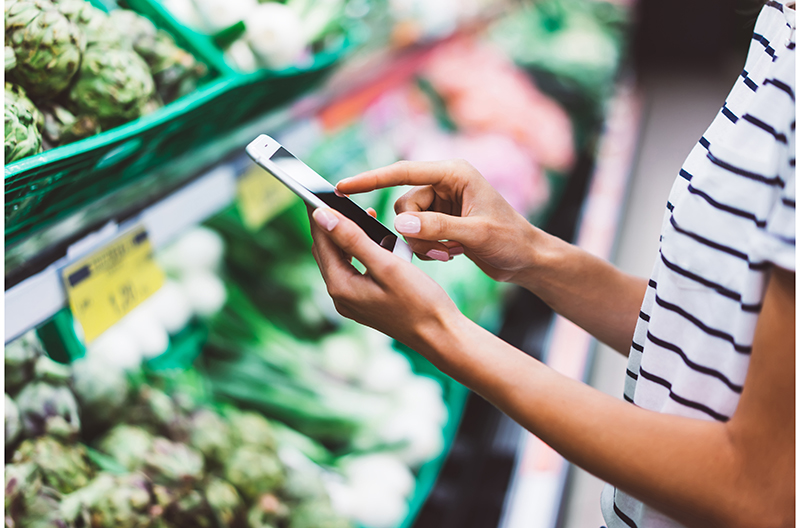Sponsored Content

Two words that best describe the CPG and grocery retail industry’s response to changes in consumer behavior are impressive and ongoing.
First, it was the pandemic that drove massive overnight changes in the ways consumers shop for grocery retail essentials like food, health and beauty products, personal care and household items, and even pet supplies.
Then it was pandemic-related issues like supply chain disruption and inflation that have caused grocery retailers to rethink inventory strategies and how consumers define convenience, loyalty and value.
At every twist and turn, brands and grocers have responded to crisis and disruption with innovation, ingenuity and reinvention. Until the next big thing pops up, I expect that many of the changes to the way consumers now shop for groceries and purchase CPG retail items will remain.
Primetime service innovation kicked into high gear during pandemic
The fact is many of the changes we see today now defined as “the new normal” – like online ordering platforms, curbside pickup, improved mobile app functionality – were already in the works but just not ready for primetime. Well, primetime came early with the pandemic, and grocery retailers jumped into action and shifted initiatives into overdrive – impacting the way they do business for years to come.
Different views of challenges: consumer vs. industry perspective
We are all aware of the nation’s supply chain challenges. And these challenges are magnified by results found in Vericast’s 2022 CPG + Grocery TrendWatch report that show consumers rank having to switch products because their preferred product isn’t available as the second highest challenge when shopping. But only 34 percent of surveyed brands and retailers think this is a big challenge for consumers.
“Retailers can help shoppers find product options by offering a strong lineup of private brands and advertising those as well as new items from national brands, both in-store and online.”
Prior to the pandemic, CPG retailers had been using a practice called just-in-time inventory models, which meant inventory was delivered just in time to get it through their distribution centers, into stores and onto shelves, so they did not have to carry costly and inefficient backroom or warehouse inventories.
When demand suddenly exceeded supply, stores and brands were caught off-guard and overwhelmed, putting product loyalty at risk, and fundamentally changing how stores and brands manage inventory, at least for the foreseeable future. And now several retailers find themselves in the opposite dilemma, too much inventory and wondering how best to move it quickly in advance of the holiday season.
Retailers launch into action
It’s very impressive how the CPG and grocery retail industry has made immense adjustments in a very short time. COVID forced retailers to become more flexible and adapt in ways I never would have dreamed possible or even practical. On the fly, retailers offered special store hours for specific shopper groups, installed plexiglass at thousands of checkout lanes, and found international brands for hot categories to keep shelves stocked with essential items that were in high demand.
Despite their nimbleness over the last two-plus years, there’s still opportunity for improvement to meet the evolving expectations and demands of consumers. Our research shows that some shopper segments rate grocery retailers lower than they rate themselves on many areas, opening critical gaps that can be closed by continuing the practice of embracing, reinventing and evolving to meet consumers’ needs.
Eighty-one percent of grocery stores rate themselves highly for having a weekly digital ad to build shopping lists, but only 48 percent of consumers agree
The meaning(s) of value
Value means different things based on life stage and demographic. From observing my son and his wife, who are millennial parents, there aren’t enough hours in the day for millennial parents juggling family and work. They value a balance of cost and convenience. As they return to commuting to work, they often debate whether to stop at a restaurant for that night’s dinner, or to order curbside pickup from their favorite grocery store. Grocery stores need to market like a restaurant to win this convenience-oriented trip by promoting ready-to-eat and freshly prepared meal options available in-store or for delivery.
Belt-tightening inflation
Money is tight for many millennial parents. Fifty-three percent struggle to afford the essentials sparking a trade-down mindset. But this doesn’t have to result in lost trips to traditional grocery in favor of discount outlets. Millennial parents (67 percent) say their grocery store has quality, reasonably priced private label brands that are often priced well below national brands. Alternatively, national brands should disrupt the trade-down mindset by continuing to advertise to close the price gap with retailers’ private label brands.
A defining moment for Gen Z
Our new consumer research has also uncovered surprising new attitudes of Gen Z. This group (ages 10-25, our survey included those 18-25) has started to come of age – with more discretionary income to spend – and I wonder if retailers are really giving them the attention they need. Gen Z has entered the age of relevance and smart brands and retailers will take notice and prepare.
It’s no surprise that Gen Z is highly engaged with their phones. Some say addicted. But it may surprise you to know they’re also a little overwhelmed and stressed out by constant messaging. CPGs and grocery retailers should carefully monitor the frequency of their communications to stay engaged with Gen Z throughout their life stages while finding ways to create top-of-mind brand awareness with this group.
Gen Z also has high expectations for online shopping functionality. Higher than other generations. Gen Z expects that you get to know and understand them through the use of algorithms and digital capabilities. They want consistent in-store and online pricing and even look for inspiration for meal ideas and recipes. Innovation and functionality that recommend items to add to their online recipe shopping basket will win their hearts and stomachs.
Gen Z is looking for products that align with their social, environmental or political values. This is especially important when it comes to food products (21 percent) and beauty/personal care (22 percent).
But what really makes Gen Z stand out from other shopper segments is their passion for sustainability. And they are looking for retailers that appreciate their values. They’re concerned about the climate and environment and will support brands that illustrate their commitment to the planet through their actions, not just their words.
What’s in-store
We’ve talked about online shopping, algorithms and digital but it’s important for retailers not to lose focus on in-store innovation and the experiences they deliver to consumers who are trip-mission-oriented and trek to their neighborhood grocery store to choose their own fresh products and produce for tonight’s meal.
While providing a quality, reliable online shopping experience makes perfect sense for replenishment orders, like personal care products, household cleaning and paper products, it’s difficult to replicate the human element needed to pick the perfect fruit, vegetable or meat.
Thankfully, there’s still the human element of the shopping experience. And with consumer loyalty up for grabs these days, grocery retailers have to think beyond the transaction to deliver the positive, memorable interactions consumers crave and appreciate and can only be experienced in person. The in-store experience is still the only place retailers can build relationships and rapport with customers and create a friendly, interactive atmosphere in which customers feel appreciated and welcomed. Attention to these details can improve loyalty and go a long way toward growing the consumer’s lifetime value with the retailer.
Juice up your in-store experience
Come up with fresh ideas! Create in-store events (sampling events, new product launch fanfare, cooking courses, nutrition tours) that are fun and engaging so shoppers look forward to their weekly trip. I believe grocery retailers that are thinking beyond the transaction have an excellent opportunity to regain some trips (or baskets) from their customers who’ve shifted some of their shopping to alternatives such as pure-play online retailers or discounters.
Retailers, take a bow
Once again, I feel CPG brands and grocery retailers should be applauded for all they’ve accomplished over the past two years to react to changes in consumer behavior and prepare for retail’s future – but there’s a shopping cart full of opportunity still ahead!
Download the Vericast 2022 CPG + Grocery TrendWatch report for results and expert analysis of survey feedback from nearly 2,000 consumers. Find out the unexpected and long-term shifts in spending attitudes toward household essentials across four key consumer groups – baby boomers, millennial parents, affluent shoppers and Gen Z.
To learn more about Vericast and Julie Companey, director, client strategy, on our Experts page, click here.

